 GD K-1 My Many ColorsSuccesses: What I felt to be most successful in this unit, was the student engagement in the process of making art. It seems that these students rarely have the opportunity to paint and make patterns on a large scale. I also think the multiple mediums allowed for very different artistic experiences within the same project. There was no prescribed outcome for this project which allowed students to make their own choices about what colors to chose and what kinds of pattern to make. What was reinforced to me throughout this unit was that student choice, in art making, can lead to higher investment in the work, which then can result in higher quality work. Challenges: Some students had a difficult time cutting out their figures. They are still young at this age and haven’t fully developed their fine motor skills. They needed quite a bit of help, especially if the poses they took on for their silhouettes were more dynamic. The final challenge was the background. For this part I let students do whatever they wanted. It acted as an extension for those who were done early. I’d like to figure out a more directed idea of what kids could do for their backgounds.
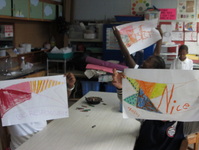 GD 2-3 Splish Splash BannersSuccesses: I think that the idea behind this unit is good. Creating banners to declare and celebrate respect in the classroom. I also found that the streamers were a fun addition at the conclusion of the banner-making. Challenges: This has been a challenging class from the start because it’s a very large group and there have been so many contrasting personalities. Classroom management has become a large focus within each class. I think that there was a lot less investment from the students in doing this project. One reason why this art exploration was not as successful is because of the lack of the personal meaning. Recognizing this, I created my next lesson to have that personal tie-in. The 2-3rd Graders are now becoming superheroes, creating a symbolic mask showing their super-strengths.
 GD 4-5 Dream School Project
Successes: In terms of student interest and investment, this has been the most successful art exploration. The project is collaborative. Students have really gotten into this idea of team-work. Last week Rashwana who was acting as a leader for the team told her group at the end of class, “I’m really proud of our work”. This was after she mediated a heated discussion about who was going to use the glue saying, “We just need to work together, disagreement is going to set us back.” Joi in another group told me, “What I like about this art program is that you listen to the kids’ ideas.” Both of these comments were very meaningful to me as a teacher, because I think collaborative art making is really good for kids to learn how to probem-solve and the skills developed by this experience are built upon and used throughout life. Joi's comment was important because student choice is so important in education and especially in art making. Choice allows for creativity. Classroom management has prevented me to do collaborative projects with my other classes. I want to find a way that students can still work together despite this. That’s for me to think more about. Challenges: At the beginning it was hard for the class to focus on my demonstration of making paper shapes. When the kids are working, they are focused and energetic about their art, it’s when they are waiting or watching that they become disrespectful. I’m learning that demonstrations need to be short and to the point. But I’ve also had experiences where demonstrations are too short and then the quality of student work suffers because a student didn’t know what to do.
*to see the full unit sequence, please visit the Lesson Plan page.
 Here is the arts curriculum for this year (in a stage of development, of course). I'm finding that a curriculum is never really "done". Teaching an after school art enrichment program has given me the opportunity to develop and implement a unique arts curriculum. I have sequenced it in four parts, one influencing the next.
DREAMS: I chose this as the first theme because I wanted students to think of the imaginative, the impossible, the extreme, the absurd, and magical. The units that surround this theme allow students to escape from realities and create their own worlds and ideas. These units I have been striving to make light hearted, fun and exciting.
SELF: These set of units surround the theme of identity. Who am I? What do I value? Where have I been? and Where am I going? Students will look inward to what makes them unique. My hope is that I will get a chance to know my students in a different way and understand how they see themselves. I believe that it is important to know and understand ourselves before we make assumptions about others.
SCHOOL: After investigating who we are as individuals we will take a closer look at our school. This theme will be broken down into two sections. What do value about our school? and What needs to be improved? My howpe is that the unit for this theme will be the same for all grade levels. It will coincide with the political campaign to obtain the Block Grant Bill to fund the renovation and rebuilding of all Baltimore City schools. Students will have an awareness of the meaning behind the campaign and will use their art to communicate their ideas.
COMMUNITY: Moving outward, beyond our school we will look at our entire community, what and who it consists of and the relation we have to our community. This is the last theme of the year. It's now pretty far into the future and I'm not exactly sure what this project will look like. It is my hope that this unit will come in the form of a collaborative mural telling the story of our community.
I believe that storytelling is a timeless and effective tool for teaching and learning. That is the lense that I am taking with this entire curriculum. I want the students to be the researchers, learners, experts, storytellers. I want them to be able to express what is important to them through their works of art.
In the end I hope that this curriculum helps my students become more aware of themselves and surroundings. I want it to empower them to continue telling their story and be perceptive of the uniqueness of others, too. These are high ambitions for a first year art teacher, I'm aware of that. But if we as art teachers don't give kids this opportunity to celebrate individuality and community, who will?
The moments of my teaching that really move me are when students feel compelled to express something that is deeply meaningful to them. Art enables children to communicate their emotions and personal stories. There are layers of meaning to be interpreted within a child's work of art. Art enables students to learn about each other, and teachers to understand student needs. This is a significant reason for why art should be advocated within schools. This story is about a student of mine. His name, for now, is Noah. Somethings that I have observed about Noah is that he likes to be by himself and work on his art alone. Often in class when I look over, I see him distracted by materials around the classroom and talking to himself. The group that Noah is in, my class of forth and fifth graders, are currently working on redesigning and building the Barclay Dream School. This project is collaborative, and students have divided themselves into groups. Noah works alone, and seems content to do so. In this project the kids in my class were encouraged to be imaginative and open to the possibilities of what their new school environment could be like. As a part of the planning process, each team filled out a Dream School Think Sheet to document the new purpose of the space and how students would feel when they were in it. This encouraged the students to think beyond what the school would look like to what feelings the space would evoke. At the conclusion of class, we shared our new, innovative ideas about how to redesign our spaces.  When Noah presented his Dream School idea, he told the class that his school would be called the "Inspiration School". Kids would be able to feel safe and they wouldn't feel left out he told us. The classrooms would have computers for everyone and the rooms would be clean and colorful. Noah would be the principle to ensure things were carried l effectively.
When Noah presented his Dream School idea, he told the class that his school would be called the "Inspiration School". Kids would be able to feel safe and they wouldn't feel left out. The classrooms would have computers for everyone and the rooms would be clean and colorful. Noah would be the principle to ensure things were carried out effectively. 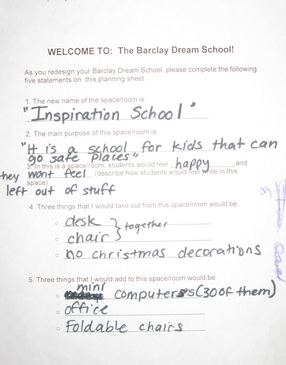 The new name of the space/room is 'Inspiration School'. The main purpose of the space/room is 'it is a school for kids that can go safe places' In this space/room students would feel 'happy' and 'they won't feel left out of stuff' Three things that I would take out from this space/room would be 'desk-chair', no Christmas decorations. Three things that I would add to this space/room would be 'mini computers (30 of them), office, foldable chairs.' In the Dream School Project Noah identified an issue that was important to him and addressed it in the new design of his school. If we as teachers allow room in our projects and lessons for our students to express their individual ideas, I think that we can give students the opportunity to be empowered by their thinking and creativity, while also allowing for an outlet to express personal needs. Now I am aware that Noah feels left out and sometimes unsafe, and I can do my best to address to accommodate him.
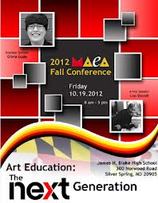 Photo courtesy of marylandarteducationassociation.ning.com Today I was invigorated by ideas and people at the Maryland Art Education Association (MAEA) conference. I saw peers, former professors, and art teachers from around Maryland. These conferences both spark new and exciting ideas to use in the classroom and also give a sense of comradery among educators. The experiences from today, further validate the importance of my profession.
Olivia Gude, one of my favorite people in the field, was there as bold as ever, discussing art education in post modern times. I love the way that Olivia allows relationships to be built between students and their artworks and students and their peers. To provide examples of this I will describe a brief part of her workshop that I attended.
We entered the space and Olivia asked us to take four colored sheets of paper, one pastel, and light and dark pencil from the back of the room. The topic of this workshop is 'The Dirty Curriculum' (intriguing title, right?). When we sat down we were asked to crinkle up our four sheets of paper, and then smooth them out. We had a discussion about the meaning of the word 'dirty'. Together we observed images and unpacked ways that the objects we were seeing could be associated to it's meaning. Sharing stories from our lives we described times when we had made a mess and got in trouble and times when we made a mess on purpose. Some also told how they had gone without cleaning a room, washing jeans, and brushing teeth. After our discussion, we picked up our paper again and rubbed it on our heads, face and feet. Searching among our own objects that we had happened to have brought to the session, we were challenged to stain our surface in any way we could. There were some people stuffing the paper in their mouths, some taking soil from near by plants, I had some blue mascara (I'm not sure why) that I used. This physical interaction with the material, automatically took away the 'fear of the blank slate' feeling. We were forced, in a very short time frame, to become familiar with the material. In a classroom setting this method can break that barrier for students who are scared of being unable to make the 'perfect' work of art, and create a NEW kind of interaction!
Proceeding with the workshop, we created narrative ripped paper collages that told a story about a time that we were messy. Before we glued our collage pieces down we were told to ask a peer to critique and offer additional suggestions to ensure strong compositions. There was trust build in this interaction by giving a peer the final say that our work was complete. Relying on others, talking about artwork together, physically interacting with materials, all of these encounters allowed us as participants to feel safe and comfortable with the art materials and with each other in a very brief amount of time.
Thank you Olivia Gude for a thought provoking workshop!
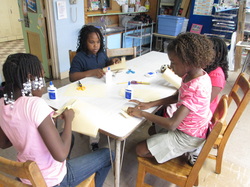 Last week I spoke of creating an environment for my classes. I've noticed that there is a difference between creating and environment and maintaining one. This week in one of my classes there was a severe lack of community and respect. I've learned a lot from this past week.
Developing the culture of my classroom is what is most important to me right now in my teaching. For me, it has been relatively simple to write my teaching philosophy based on my own personal experiences and core values. I believe that children should learn and grow in a safe and nurturing environment. They should be guided through experiences that enable the development of their art vocabulary and skills. With these tools children will have what they need to express and discuss their ideas. I further think that students should take an active role in their own educational experience by asking questions, investigating ideas, and arriving at possible outcomes.
The challenge that I am facing, as a new teacher working in an urban environment, is defining the culture and climate of my art classroom. I need to figure out how my teaching philosophy melds with who my students are, what they know, and what they need. On Wednesday I had a rough class. There were many contributers to the disorganized chaotic outcome. In the first half of class I had to shut down the art project because I was concerned for student safety. I didn't have a back up plan ready to go, and I was flustered by the arguments and frustrations of my students. A teacher from across the hall came in and loudly projected her voice at my class telling them to be quiet. It was embarrassing for me to feel out of control. I have now realized, in retrospect, that I had not yet spent time building a community. The children don't know me, and I really don't know them either.
Teaching is a reflective practice: doing, observing, reflecting, refining, and then doing again. Reflective practices allows for growth. This week there was a large lack of community in my class and next week I am going back to spend time with my class re-identifying expectations, and exploring how we want to feel in our art classroom . Kids will create two drawings of themselves, one illustrating what makes them upset, the other showing what makes them feel safe and happy. We will share these as a group and discuss the ways that we individually and collectively can make each other feel good about making artwork.
I know that my teaching philosophy will morph over time and with new experiences, but I will strive to first develop and then maintain that safe and respectful environment.
I have so many great art projects planned that centralize around the themes of dreams, self, school and community. But I know that the art making will only be productive and meaningful if students can feel safe and free to express themselves.
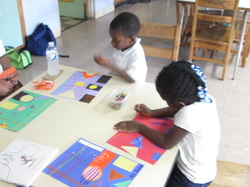 This week has been about setting up the classroom environment. I feel that I have so much to learn about each one of my students and how they work together and interact with one another. In my Middle School art class we identified three personal values that we each possess. We categorized our values into three sections: Values that we revealed to the world, values that were slightly concealed and values that were completely hidden from others. This activity gave me (and the entire class) an idea of the strengths that we hold collectively. We discussed how we can work together utilizing our values as a team. We are continuing on to make colorful identity mandalas to display and showcase the three values that we each possess.
In every class we have been developing an Art Room Manners contract. This is a list, generated by the class, of rules or "manners" that we all agree to abide by throughout the year. We also decide the consequences together, too. This classroom management strategy enables students to have impute into how the class will be structured and have a sense of ownership over his/her education.
This week I have also been asking students about their previous art making experiences and asking them to tell me what they are interested in making this year. I strongly feel that it is my job to get to know my students and tailor my lessons and units to address their interests and needs.
This week my objective is to plan the curriculum for the next few weeks based on student interest. I will also begin to solidify my overall community arts project for this year which will be centralized around the on the theme of storytelling.
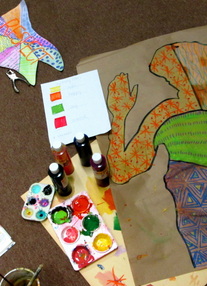 Today is the first day of the after-school enrichment program! I am excited to begin teaching and getting to know my kids. The lessons that I have planned allow room for creativity and personal expression so that I can begin understand what values these students find important and understanding their processes of thinking. After this first week, when I will be teaching grades Pre-K through 8, I will have more of an understanding of what ideas to focus on and I can concretely map out the curriculum. This is an adventure. I'm dedicated and open to the possibilities that will be cultivated this year. This week is a really about developing a classroom community, getting to know my students, being open about who I am, and making art together. We'll be setting up the stage for what is to come.
I'm going to attempt to post my lesson plans at the conclusion of each week with reflections on strengths and challenges. This will both enable me to process and debrief from the week, modify my lessons for next time I teach them, and it will become a resource for other artist/teachers.
But for now....a couple more things to prepare, and HERE. WE. GO.... ------->
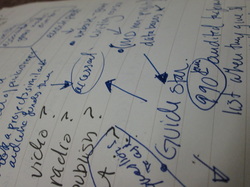 I believe that it is an exciting time to be a part of the world of education. There is a buzz as we see the Common Core Curriculum and STEM (Science, Technology, Engineering and Math) emerging into schools with great potential. I see these initiatives as being steps towards more holistic learning in which different subject areas, and ways of problem-solving will overlap and become connected. Isn't this a perfect time for art to play a vital role in the education reform? Art is a tool to connect different ways of thinking, it is a means of exploration and discovery, and a way to ask big questions. This is the time for art to have a voice and be recognized as essential component of education for children! Being freshly out of school (graduate school to clarify) myself, I'm excited to be a part of this transformation. But I also question my exact role in all of this actually is. - In what ways should I connect with other teachers?
- How should my curriculum be scaffolded for my after school program to support what kids are learning during the school day?
- How much influence should my students directly have on structuring the curriculum?
- What are my main objectives for learning?
- What are the schools main objectives?
- What are Baltimore's main objectives?
With this in mind I have been brainstorming, mapping, and writing out my ideas for this coming year. Barclay Elementary Middle School is a community school. Being a community school means there are many partnerships with neighboring non-profit community organizations, there is significant parent involvement and many additional volunteers who run programs during the day and after school. Whatever emerges from this year should embrace all of these layers of the Barclay community.
In four days I begin my placement at Barclay Community Charter School and I feel a lot of anticipation as the time approaches. I'm excited for this new experience, to meet many many children, parents, and community members, and to make art together. Through this excitement I am realizing the expectations that I have for myself this year as well.
Within the year, I will explore the ways that art, art education, and fine art can all influence the quality of education for students within a public school. I think that it is important, also, that students have a hand in their own education, by taking on leadership roles in the classroom, determining what is significant and relevant in their own lives and articulating what is needed in order to succeed.
This is a time of significant potential growth in education, with the CORE curriculum emerging into selected subject areas, and the STEM program being integrated into after school programming. How can students be a part of this development?
|



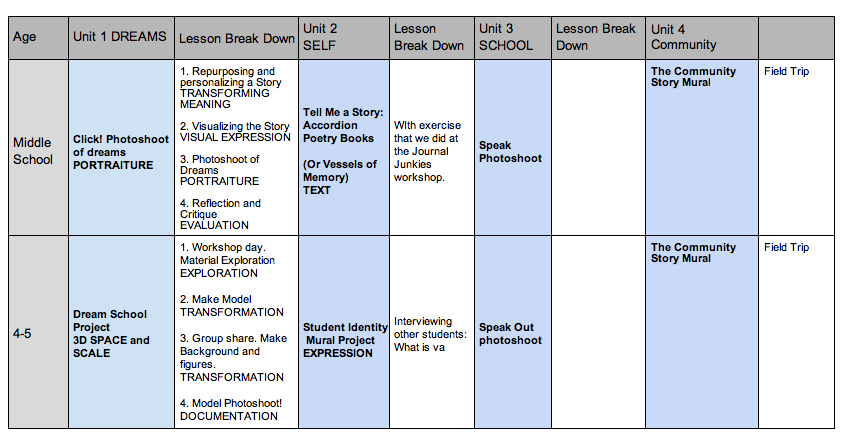
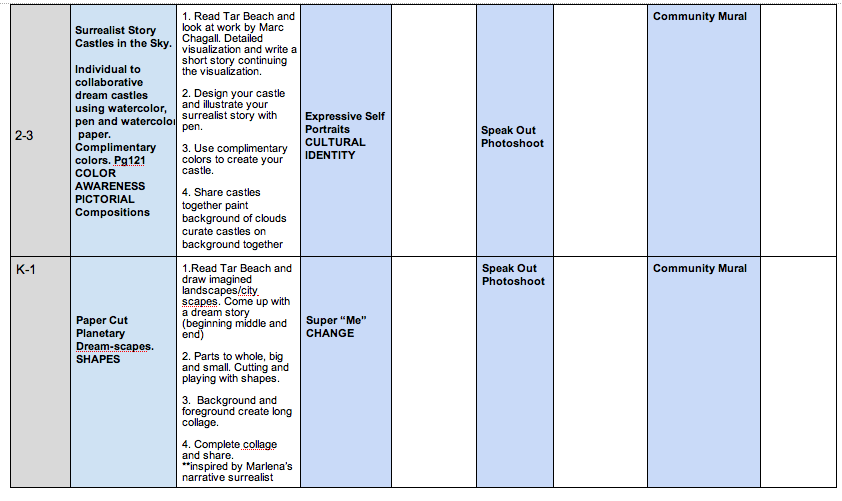








 RSS Feed
RSS Feed